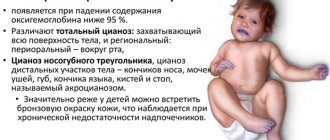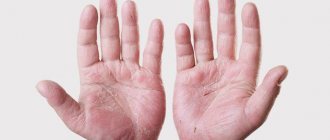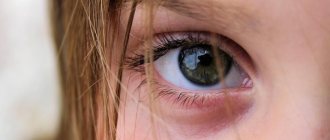Why does a child’s skin peel and peel off the skin on his fingers and toes? What does this mean? Now let's look at this issue. Often scrupulous mothers notice that their babies have flaking.
It is very important to determine the cause of what is happening before you start smearing your child with all possible creams, gels and oils.
Therefore, first show your baby to a qualified specialist. He will be able to determine the reason. Even if it is completely banal, it is better to be safe when it comes to a child.
In medicine there is such a thing as desquamation. This diagnosis is made only by a doctor of narrow specialization.
Skin problems on the arms and legs of a child
Any change in a child’s skin should attract the attention of adults. This is especially true for parents of young children who do not yet know how to explain what is bothering them. Various kinds of rashes, red spots appear on the arms and legs, the skin flakes and peels. The following problems may appear on the limbs:
- redness of large areas of the skin;
- small white, pink and red spots;
- bubbles with clear liquid inside;
- large star-shaped rashes;
- papules;
- peeling;
- peeling of areas of the epidermis;
- itchy dry rash;
- inflamed subcutaneous bumps that itch;
- purulent pimples;
- large blisters;
- rough spots.
Peeling of a newborn's foot due to improper care
How does desquamation develop?
The skin is peeling off on the child's fingers.
The skin on the child's hands and feet is peeling off gradually. As a rule, a slight itching appears first, which is observed periodically. Further, the itching intensifies, the skin peels off, the child begins to scratch it more and more often, causing it to become hyperemic and inflamed.
At this time, small bubbles without any content appear on the fingertips and interdigital areas. Then these blisters increase, capturing more and more healthy skin. When the baby itches, the blisters break and the skin peels off the hands. In place of the peeling skin, new skin appears, pink and thin.
Desquamation is not always accompanied by itching. In most cases, the skin on the hands peels off in spring and winter. This happens due to a lack of vitamins. Sometimes peeling goes away on its own, leaving no traces.
Causes of dry skin on fingers, palms and feet
Various reasons lead to problematic skin on a child’s extremities. In infants, the skin on the feet and hands may become rough due to improper care or hypothermia. Babies are very sensitive to changes in the external environment, so hard water often leads to dry skin on the hands and feet.
In older children, the skin may begin to peel and peel due to exposure to wind, water and frost. With frequent contact with water, the skin between the fingers peels off. The lack of vitamins and microelements in the body and dry air in the nursery have an effect. The skin on the fingers, palms and feet flakes and peels as a result of the following reasons:
- Fungal infections of the feet.
- Allergies to food, medications, pet hair, household chemicals.
- Scarlet fever. This is an infectious disease in which the surface of the palms and feet peels off.
- Diseases of the pancreas can manifest as peeling skin on the fingers.
- Worms. Parasites cause damage to the skin in any part of the body.
- Scabies.
- Functional disorders.
- Dysbacteriosis.
- Staphylococcal and streptococcal infections.
- Dermatosis.
The initial stage of psoriasis on the fingers
- Psoriasis. This disease looks like flaky white spots.
- Vesicular infection. Appears on the feet.
- Diabetes. The skin cracks on the tips, pads of the fingers and between them, and when pressed, it bursts.
- Hyperhidrosis of the feet. It usually affects teenagers. Expressed in increased sweating of the feet.
- Herpes zoster.
- Genetic and hereditary diseases.
- Contact injury.
- Chemical, thermal, radiation damage.
- Stress.
- Hormonal imbalances in the body.
- A sharp change in climatic conditions.
- Lack of hydration.
- Incorrect care.
Peeling skin on the palms: photos, possible diseases, care tips
If the skin on your palms peels off even with regular care and the absence of external irritants, then this is a reason to think about your own health.
Such manifestations indicate the presence of a pathology in the body, which is provoked either by the penetration of an external infection or by changes in the human immune system.
Determining the exact cause is possible after examination and consultation with an immunologist and dermatologist.
Possible diseases
Visual diagnosis of skin diseases, in which the skin on the palms is very peeling, is difficult. Symptoms of diseases overlap with each other, often overlap each other and are characterized by similar starting factors. The trigger for the manifestation of irritation on the palms is:
- stressful situations and nervous tension;
- hormonal changes;
- immunodeficiency (the skin on the hands dries and cracks);
- dysfunctions of the gastrointestinal tract;
- hand injuries and damage.
To determine the true cause of deviations, laboratory tests of damaged tissues are required. In some cases, a dermatologist will only need a visual examination to make a diagnosis, and sometimes microscopic examination of scales from the lesions is indispensable.
Psoriasis
According to doctors, psoriasis or chronic dermatitis is a hereditary disease that, according to statistics, affects 5% of Russians.
On the palms, symptoms of the disease appear if other parts of the body are already affected.
Initially, red spots the size of a coin appear with cracks and peeling, which later become coarser, thicken, and turn into round plaques with flaking skin.
The lesion affects either a local area or the surface of the palm as a whole. Nail plates are often affected, softening and peeling off.
Psoriasis is an incurable disease and drug treatment puts the disease into a stage of stable remission, during which external manifestations disappear.
Eczema
This is the name for superficial inflammation of the skin, manifested by itching, burning, redness and rashes of various natures. Eczema varies in types depending on the forms of manifestation and the cause of its occurrence.
Often occurs as a response against the background of increased sensitivity to allergens, external irritants, or as a secondary disease against the background of infection of wounds, cuts, scratches.
Characteristic signs of eczema:
- wet type: blistering rashes on the skin with serous fluid, burning, itching, peeling of spots after opening of the pustules;
- dry type: peeling skin on the palms and fingers, redness, pronounced dryness, cracks, itching.
Treatment of the disease begins with restoring the hormonal balance in the body in conjunction with local medicinal treatment with antiseptic and anti-inflammatory agents. Eczema, like psoriasis, is incurable, so the goal of treatment is remission of the disease, and the patient’s task is to take daily precautions to reduce the risk of relapse.
Allergic dermatitis
For people suffering from atypical reactions to external irritants, contact with detergents or cosmetics, as well as the use of medications or food, can lead to dermatitis or inflammatory skin disease. The allergic form is divided into two types:
- contact, in which the triggering factor is direct contact with the allergen (redness, itching appears, and skin may peel off the fingers);
- toxicodermic, when the irritant acts from within the body.
Antihistamines and medicinal ointments restore the skin while eliminating interaction with the allergen substance.
Mycosis
Fungal infection occurs through damaged areas of the skin and affects both the palms and nails. Along with peeling skin, redness, dryness, ulcers and itching appear. A characteristic feature of the advanced stage is a red rash on the palms. Most often found among housewives and food industry workers.
Diagnosis of damage by pathogenic microflora is carried out in a laboratory (scales are taken from the affected areas), only after which an effective treatment regimen is selected. It usually consists of antifungal ointments, less often with the use of systemic drugs.
Skin peeling off palms photo
In addition to skin diseases, the situation when the skin on the palms peels off can be caused by everyday, trivial reasons:
- Solar, chemical or thermal burn of the skin surface.
- Dry skin and insufficient hydration due to vitamin deficiency and dehydration.
- Contacts with harmful substances due to professional activities.
- Frequent contact with water with its aggressive chemical composition.
All this also causes irritation and peeling of the skin on the inside of the hands and fingers. Thus, when the skin peels off the palms, the cause can be both everyday situations and skin diseases of various natures.
Making an accurate diagnosis based on laboratory testing is necessary because diseases have similar symptoms but require different treatments.
Consultation with a dermatologist and immunologist will contribute to a speedy cure.
Source: https://nakozhe.com/oblazit-kozha-na-ladonyah.html
Diagnostic methods
If the skin on your child's fingers peels off, you should contact your pediatrician. It is impossible to treat the disease on your own, as incorrect therapy can aggravate the situation.
After examining and studying the medical history, the doctor will prescribe treatment or send the patient for a consultation with a dermatologist. To clarify the diagnosis, the following procedures may be necessary:
- donate blood, urine and feces for analysis;
- scraping;
- examination to detect diseases of internal organs;
- allergy tests;
- X-ray of the chest organs;
- biopsy of affected skin;
- submit biological material for bacteriological culture.
Treatment of possible diseases
Treatment for skin problems depends on the cause that caused them:
- If peeling of the feet and hands is caused by a lack of vitamins A, B, C, E, the doctor will prescribe a complex of vitamins and minerals and create a special menu for the child.
- For allergic problems, it is necessary to eliminate the allergen and take antihistamines for 5-7 days.
- Fungal infections on the skin can be eliminated using various creams and ointments. The drug is selected depending on the causative agent of the disease. Children are prescribed the drugs Radevit, Aekol, Mikozan, Clotrimazole. Apply ointments and creams to previously washed areas of the skin 2-3 times a day for 10-30 days. Therapy is combined with taking pills.
- Skin treatment for infectious, parasitic and endocrine diseases is symptomatic and is aimed at eliminating unpleasant sensations (use of creams and antihistamines).
- Peeling due to dysbiosis is treated with drugs to eliminate gastrointestinal problems.
A prerequisite for restoring the skin is to increase immunity. For skin pathologies, patients are prescribed medications that strengthen the immune system. Local skin regenerating agents are used: Diaderm, oil solutions of vitamin A, D-Panthenol, Radovit. It is recommended to rub them in 2-3 times a day.
Traditional medicine can be used for treatment only after it is known what caused the peeling. For some diseases (parasites, scabies), baths cannot be used. Chamomile, calendula, string and sea salt will help relieve itching and irritation of the skin. The water for baths must be heated to 40 degrees, and after the procedure, treat the limbs with a softening cream.
An important factor influencing recovery is hygiene. Hands and feet should be kept clean. In case of fungal diseases, it is necessary to buy your child clothes and shoes made from natural materials. The patient should have his own towel and bed linen, which must be washed in hot water to prevent relapse.
Preventive measures
It is impossible to protect a child from all diseases. However, if you follow simple rules, the likelihood of skin problems is minimized. The main condition for prevention is proper care of the child’s skin.
It is necessary to ensure that the baby's hands and feet are clean. Hypothermia or overheating of the extremities should not be allowed. After washing, wipe your hands and feet dry between your toes.
To prevent peeling due to vitamin deficiency, it is necessary to include in the child’s diet foods containing vitamins A and E. Children should eat carrots, dairy products, cheeses, apples, pumpkin, eggs, plums, fish, and vegetable oils. However, there is no need to feed your baby only these foods; the diet must be balanced.
When visiting swimming pools, you should make sure that your child has his own shoes, as he can become infected with fungus when using other people's things. It is necessary to monitor the emotional state of the baby. Overexcitement and stress can also lead to flaking of the skin. Walking in the fresh air and physical exercise will help strengthen your child’s immunity.
The outer covering of the body, the skin, is one of the largest human organs. It performs a number of important functions: protection from the negative influence of environmental factors, maintains and regulates body temperature, and takes part in the processes of metabolism and respiration.
In the process of growth and development, the child learns about the world thanks to the sensitive receptors of the skin (tactile, pain, temperature). That is why disruptions in functioning affect the functioning of the entire organism as a whole. And vice versa: various pathological manifestations, in particular, dry skin on a child’s hands, can be signs of disease.
Useful tips
If you notice peeling skin on your child’s hands, use our tips:
- Move away all household chemicals so that the child cannot accidentally get their hands dirty.
- Take good care of your hygiene.
- Provide a balanced diet.
- Make sure that your baby does not scratch the itchy skin, as he may introduce some kind of infection into the wound.
- To prevent scratching, keep your child's nails short. You can also wrap your fingers in bandages.
It is important to understand that flaky skin on a child’s hands is a reason to be wary. If it’s all about nutrition, then it’s okay, but if the symptom is caused by some disease, then you can’t hesitate. Streptococcal infections and fungi, for example, are contagious. If you delay a visit to the doctor, then everyone who comes into contact with the child can get sick. That is why you should not delay in seeking advice from a pediatrician.
Features of children's skin
Regardless of the location of the body area, the skin of a child, like an adult, consists of three layers:
- epidermis - outer, very thin and actively growing layer;
- dermis – located under the outer layer;
- subcutaneous fat is especially developed in newborns and begins to form at the 5th month of intrauterine development.
Epidermis is the upper (horny) layer. In newborns it is very thin, but prone to rapid division and regeneration. Due to its immaturity, the outer layer is easily wounded and prone to penetration and spread of infection.
The middle layer, the skin itself, contains sebaceous and sweat glands, which are already quite well developed in utero and produce the lubricant that coats the baby at birth. The dermis also contains a well-developed network of blood vessels that ensure the function of skin respiration and metabolism.
In the child’s dermis there are cells responsible for immunity to allergens, so manifestations of allergic reactions occur on the skin.
The subcutaneous fat layer is well developed in newborns, but differs in its structure in different parts of the body. It is the fat layer that ensures high heat production in children.
Why does the skin on my child's hands peel?
The baby's dermis developed in utero surrounded by fluid, and after birth it undergoes adaptation processes to new environmental conditions.
In the first months of life, both the color of the skin and its condition change. Rashes, irritation, and sometimes peeling and micro cracks may appear. These processes are physiological.
But if they are very pronounced and do not go away for a long time, this may be a manifestation of the negative influence of external factors:
- Reaction from the dermis to food. Allergic reactions in children of the first year of life manifest themselves in the form of rashes or peeling. This can happen both during breastfeeding and when adding complementary foods from new types of foods.
- Reaction to household chemicals. Dryness and flaking of the skin can be caused by detergent for washing children's clothes or shampoos and bathing gels. Also children's cosmetics: creams, powders are of poor quality or made with the addition of flavors, preservatives or other various additives.
- Chlorinated water. Frequent bathing in water with a high content of chlorine, visiting the pool or washing children's clothes in such water provokes irritation and peeling.
- Excess ultraviolet rays. Long exposure to the sun without protective equipment causes loss of moisture from the upper layers of the dermis and subsequently causes dryness and flaking.
- Lack of vitamins. Most often it appears after illnesses, with reduced immunity and a lack of vitamins in food in the spring.
- Poor quality clothes. Clothing made from synthetic fibers can cause irritation and dryness. This also applies to children's toys, bedding and blankets.
- Pathological processes of internal organs. Dry skin can be a warning symptom of metabolic disorders and chronic diseases.
- Cold season. With a sharp change in temperature or exposure to cold, the top layer of the baby’s hands loses moisture and elasticity, which leads to peeling.
In cases where dryness and flaking continues for a long period, this can lead to the appearance of cracks in the hands. They can be quite painful, as a result the child becomes restless and moody. And eliminating such consequences and treating cracks is more difficult than preventing their appearance.
Internal reasons
Skin pathology is very often provoked by problems with internal organs, infections, dehydration, helminthic infestation, pathological processes and other issues.
Weakened immunity
Lack of vitamins and minerals greatly weakens the immune system. The appearance of the skin reacts especially acutely to vitamin deficiency of groups A and E, which are responsible for nourishing the dermis.
The immune system also weakens after long-term illnesses; staphylococcus and streptococcus bacteria often take advantage of this moment.
The parasites that inhabit the human body also contribute to the undermining of human health by poisoning the body. If the skin on your hands begins to itch or peel, you should immediately carry out the necessary tests.
Genetics
Genetic predisposition to dermatitis quite often causes diseases such as:
- Psoriasis;
- Atopic dermatitis;
- Eczema.
They most often express their symptoms on their hands. In this case, you can observe redness, cracking of the skin, and rejection of the upper layers of the dermis in large areas.
Hormonal disbalance
It is not uncommon that the skin begins to peel off due to hormonal imbalance caused by medications, both external and internal use. Hormonal imbalance is observed in pregnant and lactating women, also during menopause.
All adolescents during puberty may also notice peeling of the skin, redness, and peeling on their hands.
Allergic reaction
If the skin peels off on your hands, redness and severe itching are observed, this may be a manifestation of an allergic reaction. Any allergy in its companions often contains allergic dermatitis. The skin itches and peels, the palm becomes covered with cracks. The entire surface of the rash begins to peel off over time.
How to eliminate dry skin on a child's hands
With the baby’s physiological adaptation to environmental conditions, when dry skin is not pronounced, you can do without consulting a specialist and eliminate the dryness with the help of baby cream or oil.
If the manifestations do not disappear for a long period or often appear and are complicated by cracks, in this case you cannot do without an examination by a pediatrician.
Treatment directly depends on the causes of skin peeling. After identifying the causes, you can decide on treatment methods.
Allergic reactions
When diagnosing an allergic reaction, the doctor prescribes a series of allergy tests to determine the allergen. Identified food products that are allergenic to the child’s body should be excluded. In some cases, additional drug treatment with antiallergic drugs and ointments is necessary.
Dry skin additionally needs care and hydration. If cracks are visible on your hands, they must be treated with a gentle disinfectant solution. Affected areas can become additional gates for infection to enter the body. And the structural features of children's skin cannot prevent or stop the spread of infection.
Temperature
Hands need additional hydration during the winter season. If there are sudden changes in temperature indoors and outdoors during a walk, adaptation does not have time due to imperfect thermal regulation of the skin. And dry indoor air during the heating season aggravates the manifestations of dehydration.
In the summer, the baby must be additionally protected from the aggressive influence of ultraviolet radiation. It is better to use a sunscreen cream intended for early childhood.
Drinking regime
The child must receive a sufficient amount of fluid to maintain water-salt balance and metabolic processes in the body.
Natural fabrics
Your baby's synthetic clothes should be replaced with items made from natural fibers: cotton, linen or bamboo. This also applies to toys and bedding and blankets.
Detergents
When washing with soap or powder, children's clothes need additional rinsing until the smell of the detergent disappears. To wash children's clothing, it is permissible to use hypoallergenic products adapted for children's age.
Vitamins
After suffering an infectious disease, taking medications, as well as in the spring, the baby needs additional vitamin supplements, dosed strictly according to age.
Traditional methods for treating dry hand skin
Traditional methods of combating dry hands can be used in combination with drug therapy after consultation with a pediatrician.
An excellent moisturizer is oil. It softens the dermis and prevents moisture from evaporating. For children's hands, you can use massage oil intended for early childhood, or olive, flaxseed, almond, and wheat germ oil.
If there are no visible wounds or cracks on the skin, the oil can be rubbed in with light massage movements.
You should not use active concentrated ointments and creams for moisturizing. The active ingredient of the ointment is quickly absorbed through the thin baby skin into the blood, and can also cause irritation and aggravate skin manifestations.
As a healing and anti-inflammatory agent, you can use decoctions of herbs: chamomile, plantain and sage. Cool to room temperature and make hand baths. You can add a solution of vitamins A and E to the decoction. This mixture is also added to the bath when bathing.
“The skin on the child’s fingers is peeling,” parents complain to the doctor. Unfortunately, this often happens...
“The skin on the child’s fingers is peeling,” parents complain to the doctor. Unfortunately, this happens quite often. And due to the fact that this symptom can be caused by various diseases, not all of them are recognized in a timely manner. Local treatment aimed at eliminating desquamation (peeling of the skin) is symptomatic and, unless the cause is established, helps only temporarily.
In this article we will talk about the most common causes of peeling of the palms, as well as which specialists should be contacted in each specific case. If your child has peeling skin on his fingers, this may be a symptom of some disease. Desquamation in itself is only a sign signaling that something is wrong in the body.
1. Contact allergy to household chemicals, soap, cream, finger paints, to anything that could come into contact with the palms. This allergic dermatosis is limited only to the site of contact between the skin and the allergen. In addition to peeling skin, children are bothered by itching. If you scratch the skin hard enough, a secondary bacterial infection will occur, which will complicate the symptoms and require antibiotic therapy.
For treatment, it is necessary to eliminate the provoking factor, otherwise the skin on the hands will peel off constantly. The fact that after stopping contact with the irritant all symptoms go away speaks in favor of contact dermatitis. It must be treated with antihistamines; severe cases are treated with glucocorticosteroid ointments. Baths with medicinal herbs are suitable for healing.
2. Lack of vitamins A, E and F. If there have been problems with digestion since childhood, the child’s skin will peel off on the fingers due to the fact that the vitamins and minerals supplied with food are not absorbed. Hypovitaminosis usually causes desquamation on the fingertips. Fat-soluble vitamins A, E and F are found in foods such as pumpkin seeds, almonds, walnuts, corn, peanuts, flaxseeds, eggs, gooseberries, avocados, as well as fatty fish. Try to enrich your child's diet with these products.
However, this may not be enough, then you can buy vitamin complexes containing these vitamins, but only after the recommendation of a doctor.
3. Drying of the skin. If your child has peeling skin on his fingers, this may be a symptom of drying out of the skin with alkaline soap. Lack of moisture will affect not only the condition of the palms, but also the entire skin. In this case, the baby should be provided with a normal drinking regime, and rough areas of the skin should be lubricated with Lipikar Xerand and Topicrem moisturizing cream.
4. Allergic reaction to long-term use of certain medications (sulfonamides, glucocorticoids, antibacterial agents). In this case, peeling occurs as a result of the influence of drugs on the immune system. The severity of desquamation depends on the degree of toxicity of the drug. Consultation with an allergist is required.
5. Photodermatoses. A peculiar reaction to ultraviolet rays can cause various skin manifestations: urticaria, erosion, peeling of the skin. You can confirm the diagnosis with a dermatologist, and always apply a sunscreen with a high spf level before going outside.
6. Cold and high humidity can cause maceration of the skin of the hands and mild frostbite. A common situation is when this happens after a snowball fight. The skin peels slightly; to eliminate the symptoms, it is enough to lubricate your hands with a nourishing cream before a walk.
7. Helminths. A nonspecific sign of the presence of worms in a baby. However, when diagnosing the causes of peeling fingers, this point should also be excluded. Helminthiasis will also be indicated by problems with stool, complaints of vague abdominal pain, sleep disturbances, and poor appetite. Worms themselves can cause an allergic reaction, leading to various kinds of dermatoses, and also deprive the child of necessary vitamins, leading to metabolic disorders. To confirm the diagnosis, it is necessary to test feces three times for worm eggs, as well as scraping for pinworms.
8. Fungal infection. It is quite easy to catch mycosis of the skin of the hands, especially for a child with a weak immune system. Mycosis can be accompanied by infection of the nails, itching, and small cracks between the fingers. To confirm the diagnosis, it is necessary to take a skin scraping from a dermatologist. If the result is positive, antifungal ointments and restorative drugs are indicated.
9. Streptococcal infection. The skin on the fingers of the child peels off during the period of recovery from scarlet fever: large-plate peeling of the palms is observed. In addition, there are signs such as fever, intoxication, sore throat with a crimson tongue, and a pinpoint rash that thickens in the area of natural folds of the skin. In this case, children are treated by an infectious disease specialist with the mandatory prescription of antibiotics. As you can see, there are many reasons for peeling skin, so we advise you not to diagnose and treat it yourself, but to consult a specialist.
Very often, attentive parents notice peeling on the fingertips of their baby. Only a qualified doctor can tell why a child’s skin is peeling off on his fingers after a thorough examination, so you shouldn’t hesitate to go to the doctor. A similar condition of the skin on the fingers can be a symptom of a serious disorder in the functioning of internal organs, as well as a sign of an allergic reaction.
Sign of scarlet fever
If a child has severe peeling and peeling skin on the fingertips, there is a possibility that this phenomenon is a symptom of the above-mentioned disease. Pityriasis-like small scales appear on the surface of the body. And large areas of the epidermis peel off from the palms or soles. But with scarlet fever, it is the fingertips that peel the most.
This infectious disease is caused by group A streptococci. Most often it develops with pharyngitis or tonsillitis. The disease may also occur after surgery or injury.
Therefore, it is best to immediately consult a doctor if your palms are peeling for a full diagnosis. After all, scarlet fever is very dangerous due to possible complications. The consequences may be infectious or allergic. However, timely and adequate treatment reduces the risk of complications.
Possible causes of peeling
If a child has peeling skin on his fingers, the first thing doctors suspect is a lack of vitamins of a certain group. There are a number of situations in which the baby suffers from disorders in the digestive system, and all the vitamins supplied with food cannot be fully absorbed. Accordingly, the skin on the child’s fingers cracks and heals slowly, because the body lacks vitamin A and E.
The skin on your hands will also peel off during an allergic reaction; it can be triggered by both household chemicals and food. Parents should remove potential irritants from the child’s environment and review the diet. Taking medications such as sulfonamides, glucocorticoids and antibiotics reduces the baby’s immune strength and can cause peeling and cracks in the fingertips.
It is not uncommon for a child to peel off the skin on his fingers, and all this is accompanied by symptoms such as:
- refusal of food;
- moodiness;
- sleep disturbance;
- stomach ache;
- defecation disorders.
In such situations, the doctor will send you for a stool test, because most likely the reasons lie in helminthic infestations. Parasites absorb all the beneficial substances that the child receives and deplete the body, so the skin is the first to react.
The child’s fingers will peel due to a fungal infection. A child can catch it anywhere, even while playing with shared toys in kindergarten, but in most cases children become infected from their parents. That is why it is so important for adults to monitor proper hygiene and their health if there is a child in the house. In the case of a fungal infection, in addition to peeling, the child’s fingers show:
- cracks;
- small papules;
- sores;
- the baby complains of itching and burning;
- there is increased dryness of the skin;
- foci of inflammation spread to new areas;
- Over time, the rash area hardens and becomes crusty.
Similar symptoms are observed if a child has peeling skin on his fingers due to a streptococcal infection. The only difference is that the clinical picture will be supplemented by fever and sore throat.
In newborns and infants in the first month of life, peeling of the skin on the arms and fingers is a normal situation that does not require intervention. The baby and his body thus adapt to the new environment. After a couple of weeks, the skin should return to normal.
The skin on the fingers also peels off with photodermatosis. This is a kind of allergic reaction to exposure to ultraviolet rays; it can be caused by a significant decrease in immunity or be an innate sensitivity of the skin. You can recognize photodermatosis by the fact that when a child goes out into the sun, his skin becomes covered with a small rash, turns red, peels, and even ulcers form. Parents, having confirmed the diagnosis in the future, should treat the skin with special sunscreens to avoid severe burns and even anaphylactic shock.
The causes of the pathological condition of the epidermis on the fingers may be hidden in improper child care. Excessive use of alkaline soap, as well as a rough towel, can damage the top layer of delicate skin and cause it to peel. The skin of the fingers begins to peel off after frostbite, for example, after playing snowballs without gloves, maceration of the skin of the fingers and hands may be observed on the fingers. This condition does not require medical intervention; it is enough to apply a nourishing cream.
Sometimes, by the appearance of peeling, you can determine what kind of disease is progressing in the body. Of course, tests will have to be taken in any case, but the doctor will still understand which direction to move in order to determine the disease. If the skin between your fingers peels off, it could be scabies. In case of peeling on the sides of the fingers, a fungus can be assumed. Psoriasis and lichen can be diagnosed if the peeling is white or pink and is localized in separate spots on the fingers and palms. Dark spots indicate ichthyosis.
As can be seen from the above, the reasons for peeling skin on the fingertips can be different, but self-diagnosis, especially when it comes to a small child, is not only stupid, but also dangerous. With your thoughtless attempts to improve the situation, you can significantly harm the baby.
Allergic reactions
Dermatologists say that these phenomena are rare in practice. After all, a very strong irritant must enter the body if the child’s skin peels off on his toes or hands. Moreover, it should only be triggered by direct contact.
Identifying an allergy is quite simple. It is necessary to analyze what new means have been introduced into use. Eliminating them usually relieves the baby of unpleasant symptoms.
If necessary, the doctor may prescribe certain medications. Folk remedies are also quite effective. Discuss them with your dermatologist first. Essential oils of lavender and tea tree, and chamomile decoction improve skin condition. Honey is great for getting rid of flaking. Both conventional surface lubrication and the use of baths are suitable.
Methods for eliminating pathological skin conditions
The principle of treatment directly depends on why the skin is peeling. If the disease is caused by a lack of a certain vitamin, therapy with immunomodulators, as well as nutrition with vitamin-containing foods, is indicated. An allergic reaction is eliminated by taking antihistamines, which eliminate itching, burning, rash and reduce the effect of the pathogen on the body. The following drugs have proven to be better than other drugs in the treatment of peeling and cracked fingers:
- Diazolin;
- Suprastin;
- Fenkalor;
- Tavegil;
- Claridol.
If the skin on the fingers peels off due to parasitic infestations, strong anthelmintic drugs are prescribed, such as:
- Pyrantel;
- Mebendazole;
- Albendazole;
- Levamisole.
If the body does not have helminths, but some other parasite - roundworms, lamblia or pinworms, the doctor adjusts the therapy depending on the individual characteristics of the child.
A streptococcal infection that affects the skin on a child’s fingers is eliminated by taking antibacterial drugs, such as:
- Clindamycin;
- Doriprex;
- Mepenam;
- Dalatsin;
- Amoxil.
It is strictly prohibited to buy the above medications to treat a child if the skin on his fingers is peeling without a doctor’s recommendation. They have many contraindications for use, and can significantly worsen the current situation.
Preventing peeling of fingers
If the skin on the child’s fingers cracks and there is excessive peeling, the parents panic and reproach themselves for not taking care of their child. To avoid hospital treatment, as well as numerous sleepless nights, you need to constantly prevent skin diseases and allergic reactions. To do this, it is enough to review the child’s diet and take care of his hygiene.
Bathe your baby every day, trim his nails several times a week, because this is where provocateurs of infectious and bacterial diseases accumulate. Make sure that the skin is constantly moisturized, use baby nourishing creams; modern cosmetology and pharmacy offer a huge amount of them.
Do not forget to ventilate the room where the baby lives, control the air temperature. Sometimes, air conditioners and radiators dry out the air and create a situation in which the baby’s skin cracks and fingers peel.
Another important aspect is to visit a doctor in a timely manner in case of alarming symptoms. Sometimes peeling can be a sign of impaired liver function, and diseases of this organ require complex treatment. By deliberately delaying your trip to the clinic, you allow the disease to progress and complicate the doctors’ work in the future. By starting therapy in a timely manner, as well as following the recommendations of medical staff, you can quickly restore the baby’s immune system and eliminate the causes that caused defects in small fingers and hands.










